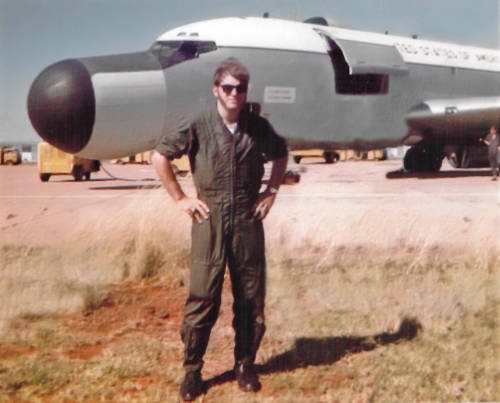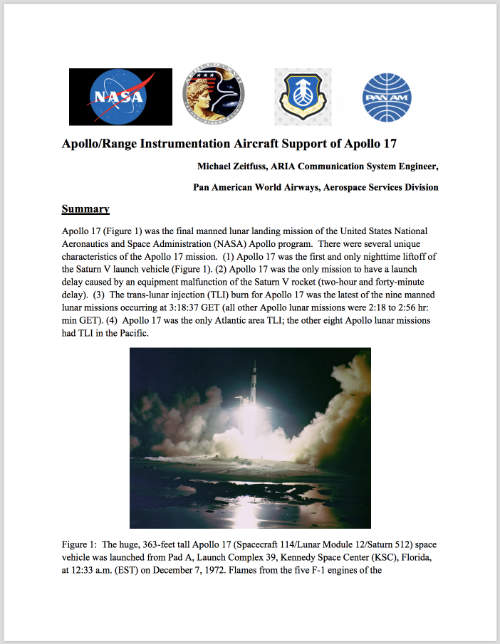Michael Zeitfuss stands in front of ARIA 2 / 326, at Darwin, Australia, on 16 April 1972.
ARIA Support of Apollo 17
Michael Zeitfuss, served as ARIA Communication System Engineer, Pan American World Airways, Aerospace Services Division.
As the 50th anniversary of Apollo 17 approaches, he has produced a wonderful overview of ARIA support for the mission. Download it further down this page.
Michael Zeitfuss stands in front of ARIA 2 / 326, at Darwin, Australia, on 16 April 1972. Apollo 16 launched early the next morning, Australian time, and ARIA 2 was there to support TLI (the Trans Lunar Injection burn) which began when the spacecraft was over western Queensland. |
Mike writes:
Personal background
I was working for Pan American World Airways, Aerospace Services Division, the prime contractor for the United States Eastern Test Range.
Pan Am was and had been the prime contractor at the ‘Range’ from the beginning 1954. Pan Am’s expertise was working with local people in establishing and operating remote bases. As the range expanded and added more and longer range bases Pan Am worked with the local people to build the base and then staff/operate the base for support of missile/rocket/space vehicles.
I started working for Pan Am in 1964. I was assigned to work on the ARIA program in early 1967 before the aircraft were delivered to Patrick Air Force Base.
I continued to work on ARIA as a communications system engineer, eventually becoming the program director responsible for the movement and transition from Patrick AFB to the 4950th Test Wing at Wright Paterson AFB, Dayton Ohio beginning in November 1975 and completing in June 1976 when I left the program.
I had accumulated over 5200 flight hours on ARIA by the time I left the program.
The Apollo Range Instrumented Aircraft
Development and test of the ARIA followed the then proscribed USAF Category I, II, and III milestones for major systems.
The airframe modifications and corresponding Category I and II milestone were performed by Douglas Aircraft in Tulsa, OK.
The Prime Mission Electronic Equipment (PMEE) development and corresponding Category I and II test milestone were accomplished by Bendix Aviation in Teterboro, NJ.
After completing the airframe modifications and installation of the PMEE, the ARIA were flown to Patrick AFB for Category III testing by Pan Am.
The aircraft air frame modifications were performed by Douglas in Tulsa, OK. The eight ARIA were all USAF C/K-135A with water injection engines for added thrust for take-off. The airframe principal modifications:
1. The large nose mounted radome that housed the 7 ft (actually 73 inches) diameter manual steerable and autotracking multi-frequency antenna.
2. Additional HF wing probe antenna on each wing tip (addition to the normal HF antenna on the vertical stablizer).
3. Additional 4th engine mounted electrical generator to handle the increased load of the ARIA Prime Mission Electrical Equipment.
4. Sound insulation covering the interior of the aircraft to reduce noise.
5. Forward crew rest area.
6. Aft crew rest area, including galley.
7. Four of the eight aircraft received special modification for the airborne light optics system, including a repurposed B-66 blister with radome, operator station in the forward cargo area, and reinforced cargo door to handle the A/LOTS pod mounted externally on the door.
Bendix did the PMEE modifications including the mounting of approx 30 racks of hardware and miles of cabling.
Pan Am was responsible for running the Category III test program and simultaneously determining how best to deploy the aircraft for actual mission support. The ARIA were specifically developed to support the Apollo program. The ARIA were considered a US national asset and were treated as such. The Apollo program had the priority and everything else was ‘non-interference basis’ (NIB) to Apollo.
The ARIA were used to support all of the Apollo missions. The ARIA program was a huge success. In the 10 years I worked on the program we supported all of the assigned missions, meet all of the data requirements, never lost an aircraft, and never lost a crew member. Our motto was ‘Flight Safety is Paramount’. The program was and is a great credit to the team work of NASA, USAF, civil service, and Pan Am team.
For ARIA support of Apollo 17, I have put together data from NASA, USAF official records, Pan Am records, and my engineering notebook.
ARIA Support of Apollo 17
Michael Zeitfuss has compiled this detailed paper on ARIA support for Apollo 17, the last Apollo flight to the Moon, December 1972. Click the image to download a 4.1MB PDF file. With very special thanks to Mike for this paper, his photo, and the background information. |

